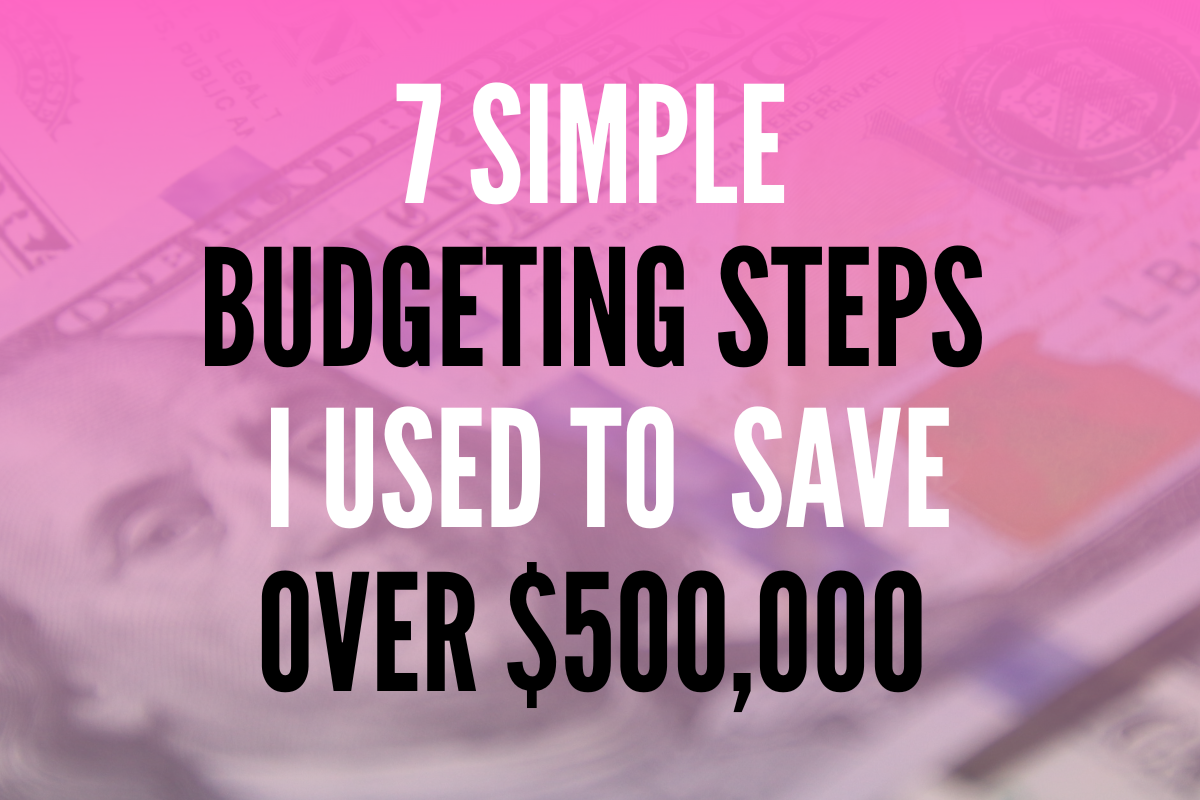7+ years ago, I sat down and figured out 7 simple steps to the budgeting process, and they helped me save over $500,000. This post describes those 7 simple steps.
This post may contain affiliate links that allow this blog to earn money without a cost to you. Many thanks if you use them. Please read my disclosure for more info.
Before I learned 7 simple steps to the budgeting process, I was 25 years old and living with my then-boyfriend (now husband). We were living the “DINK” lifestyle (aka Double Income, No Kids). While we were not going into debt every month, we weren’t saving a lot (if anything) either. Every month, something would come up that would catch me off guard… For example, a friend would get married, a family member’s birthday would come up, or some kind of holiday would have me spending money. It felt like it never ended.
Finally, one evening I decided to get to the bottom of what was happening. I sat down and “guesstimated” all of my monthly expenses. Based on my monthly expenses, I should have had hundreds of dollars left over each month! WTF! Where was all my money then!?
So then (and here’s where the big ah-ha came in), I guesstimated all of my yearly expenses. You know, the random expenses that happen once a year that you forget to budget for… This was eye-opening! When I totaled up all the money I spent on my monthly expenses plus the things like:
- Gifts (for weddings, baby showers, birthdays, and holidays)
- Insurance (that only happened twice a year)
- Vaccines and care for my two dogs
- Eating out (a lot!)
- Buying clothes
…And compared my totals to what I made every year, I was spending all, if not a little more than what I actually made. It was a surprise that I hadn’t gone into debt!
So after that big ah-ha, I decided I needed to change things, stat!
Learn More: Why Am I So Broke All the Time?
Below you will find the 7 simple steps to the budgeting process I used to save over $500,000. You read that right! Since taking these simple budgeting steps over 7 years ago, I have increased my net worth by over $500,000. Since then, a lot has evolved in my life, BUT I believe that the foundation of being able to save that much started with these 7 simple steps to the budgeting process…
1: Determine something you really want or dream of having or doing, and write it down.
- Here are some examples: “I want to go on a tropical cruise for 2 weeks”, “I want to be debt-free”, “I want to be super fit”, “I want to buy a home”, “I want a nice car”, “I want to retire early.” That wasn’t so bad, was it?
- This may seem simple, but it is the most important of the 7 simple steps to the budgeting process because it will help motivate you to stick to your budget later. If you get overwhelmed reading this post, I want you to think about your dream and keep pushing through.
2: Determine how much money you need to get to your want or dream.
- You simply need to research how much your dream actually costs. If, for example, you want to get super fit, find out how much a personal trainer and/or nutritionist would be. If you want to live by the beach, find out how much a house there costs and how much you need for a down payment. Go ahead and Google it now.
3: Figure out how much you spend...
Step 3a: …every month
- To budget for the month, start by writing down your reoccurring monthly household expenses, and use your past bills and statements to get an accurate estimate for these numbers. Here are some examples of household expenses you should account for (if you have others not mentioned here, make sure you include those too):
- Rent/Mortgage
- Phone/Cell Phone
- Cable
- Insurance
- Internet
- Trash
- Water
- Electricity
- Gas
- Charity
- Housekeeper
- Gardener
- Debt Repayment
Next, estimate how much you spend every month on everyday expenses. Again, remember that some bills will be the same every month of the year, but others (like fuel) will change from month to month (based on how much you’re driving, for example). Make sure you account for these changes, so your monthly number is accurate for each month. To do this, over budget for categories that change from month to month since it’s better to have the extra money in a category when you need it than not enough.
- Fuel (for your car)
- Groceries
- Eating out
- Household goods
- Personal care items
- Entertainment
- Dry cleaning
- Clothes
- Daycare
- Prescriptions
Step 3b: Figure out how much you spend every year…
- Many people recommend that you budget every month, and I agree. However, for you to see the whole picture and budget correctly, you need to zoom out and look at the big picture. There are sneaky items that many people don’t account for when they only budget every month. Budgeting for the year will help eliminate this problem.
- To budget for the whole year, start by writing down your reoccurring yearly household expenses that you know to anticipate. For example, you probably expect to pay for your car registration every year.
- Next, guesstimate how much you spend in a year on things that normally catch you off guard and break your budget. Some examples may include:
- Medical expenses/emergencies
- Home repairs
- Car maintenance
- Bank fees/interest
- Loaning people money
- Car insurance (I pay mine every 6 months, so it used to catch me off guard)
- Life insurance (I pay mine every year, so it used to catch me off guard too)
- Birthdays
- Christmas
- Other gifts (Valentine’s Day, Mother’s Day, Father’s Day, Baby Showers, Weddings, Anniversaries, etc.)
- Pet expenses
- Finally, determine how much you spend, save, or need to budget every year for:
- Vacations
- Retirement
- Your emergency fund
- Additional tax (if you find yourself owing every year)
- Investing
- Total all the numbers to see exactly what your “outflow” is in a year.
- Note: I say “outflow” because diverting money into savings counts as an “outflow” because you’re not allowing yourself to spend that money on other things, but technically it isn’t going anywhere.
4: Figure out how much you make every year.
- The number we care about here is how much you take home every year (after taxes, social security, etc.). If you have any side hustles, or you get reoccurring cash gifts, bonuses, or investment income, you should also include those in this number.
5: Compare what you spend every year to what you make every year.
- Now that you know how much income you make every year and, you should have guestimated ALL of your expenses compare the totals to see if you are making more than you spend or spending more than you make. If your budget shows that you have extra money, but you never actually do, go back and review your monthly and yearly expenses to check for things you missed. It’s also helpful to review your bank statements to account for all expenses.
6: Create a balanced budget based on what you make and spend.
- Now that you know what you make and spend in a year, you need to consciously plan your budget, and take into consideration things that recur every month, your wants and dreams, things you should spend/save money for but haven’t, and things that usually catch you off guard.
- Tip: I recommend doing this exercise in Excel so you can easily make adjustments and changes.
- Start by writing the amount of money you make (remember, it’s your take-home pay) at the top of the worksheet.
- Next, subtract how much you want to spend or save for your #1 goal.
- Then, subtract out all of your monthly costs in the order of importance.
- Finally, subtract the monthly average of all of your yearly “sneaky” expenses. That will be the total yearly cost of your “sneaky” expenses divided by 12.
- After you’ve budgeted, you should have every dollar accounted for. The total of how much you spend and save should equal how much you make. If you’ve budgeted more than you make, you need to figure out how to increase your income and/or how to make cuts, starting with the least important categories in your budget or doing a combination of both.
- If you have extra money to budget, you can add the extra money to your goal, save it, or create an additional goal to save money for.
7: Be a conscious spender.
- After doing this exercise, you probably made a few adjustments in how you spend your money. Many people dislike budgets because they feel they’re restricting. However, if you followed my advice and budgeted for your goals and dreams first, following your budget should be inspiring because it is getting you closer to getting what you really want in life.
- Now that you have a budget, it’s important that you know where you are at all times (you know, are you overspending or not?). There are studies that have been done that show that the richest people know exactly where they stand financially at any given moment.
- The tool that I have used since 2012 is called YNAB. YNAB stands for You Need a Budget. It is a software that Money Hacking Papa came across on Reddit, and it has changed our lives! The coolest part of YNAB is that it allows you to create a budget and then instantly update your budget after every single transaction you make using their app and website. So, rather than wondering if you’ve overspent or not, you can actually look at your budget in real-time and either say, “Yay! I can buy those gorgeous new shoes because the money is in my budget,” or “Hmmm… I’m going to wait on those shoes because that dream vacation is more important to me” OR even, “Ok, I’m going to buy these shoes, but realize that I need to spend less on eating out this month.” Basically, you have full control over your finances and the decisions you make. YNAB offers a free trial for their software, AND they offer a ton of free videos and webinars to help you understand budgeting and their program. So, if you’re serious about budgeting and achieving that dream from step 1, go check it out.
- If YNAB seems too expensive or you just don’t like it, I’d recommend “the envelope system” (although this system doesn’t work well if you want to use credit cards to get points). Eventually, I’ll write a post about the envelope system, but until I do, just Google “the envelope system,” and you’ll find plenty of information on how to use it.
- Finally, if you’re more of a pen-and-paper gal, you can always get a budget planner like this one on ETSY.
I hope these 7 simple steps to the budgeting process help you achieve your financial goals. It may take a few days for you to go through these steps, and that is ok, just take it one step at a time. Remember, it took me over 7 years to get to the point I’m at today, but it would never have happened if I didn’t take a long hard look at where I was spending my money 7+ years ago. If you have questions or comments, you can put them in the comments section below or drop me a line via the contact form.





